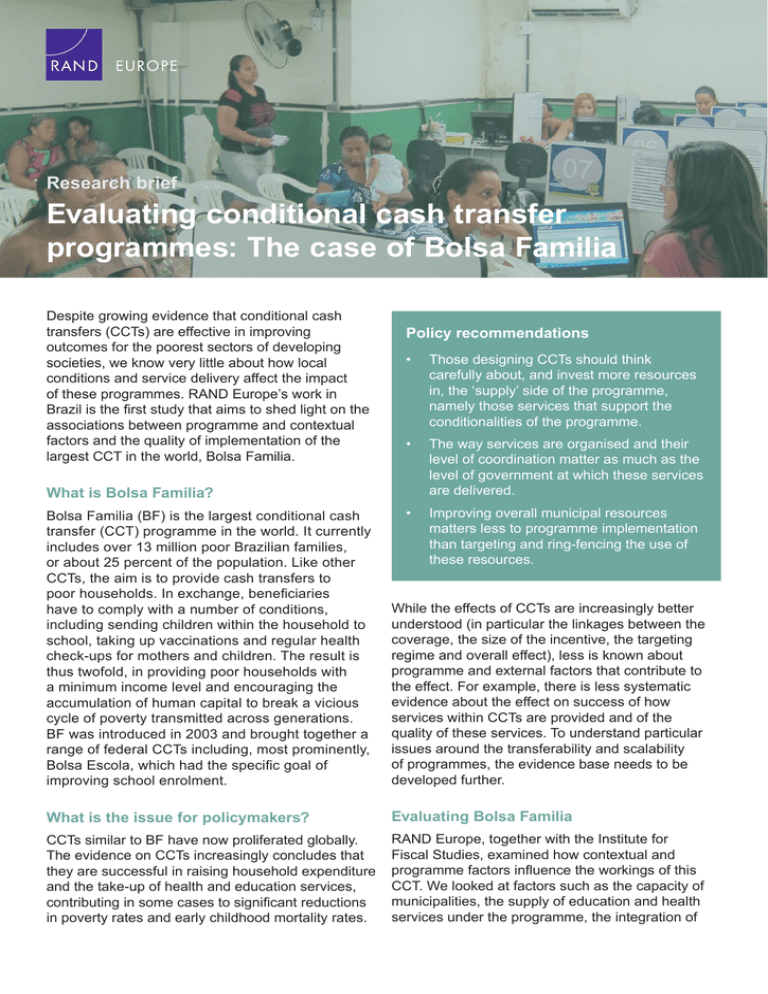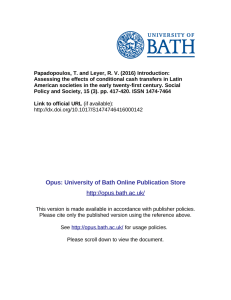Evaluating conditional cash transfer programmes: The case of Bolsa Familia Research brief
advertisement

Research brief Evaluating conditional cash transfer programmes: The case of Bolsa Familia Despite growing evidence that conditional cash transfers (CCTs) are effective in improving outcomes for the poorest sectors of developing societies, we know very little about how local conditions and service delivery affect the impact of these programmes. RAND Europe’s work in Brazil is the first study that aims to shed light on the associations between programme and contextual factors and the quality of implementation of the largest CCT in the world, Bolsa Familia. Policy recommendations • Those designing CCTs should think carefully about, and invest more resources in, the ‘supply’ side of the programme, namely those services that support the conditionalities of the programme. • The way services are organised and their level of coordination matter as much as the level of government at which these services are delivered. • Improving overall municipal resources matters less to programme implementation than targeting and ring-fencing the use of these resources. What is Bolsa Familia? Bolsa Familia (BF) is the largest conditional cash transfer (CCT) programme in the world. It currently includes over 13 million poor Brazilian families, or about 25 percent of the population. Like other CCTs, the aim is to provide cash transfers to poor households. In exchange, beneficiaries have to comply with a number of conditions, including sending children within the household to school, taking up vaccinations and regular health check-ups for mothers and children. The result is thus twofold, in providing poor households with a minimum income level and encouraging the accumulation of human capital to break a vicious cycle of poverty transmitted across generations. BF was introduced in 2003 and brought together a range of federal CCTs including, most prominently, Bolsa Escola, which had the specific goal of improving school enrolment. While the effects of CCTs are increasingly better understood (in particular the linkages between the coverage, the size of the incentive, the targeting regime and overall effect), less is known about programme and external factors that contribute to the effect. For example, there is less systematic evidence about the effect on success of how services within CCTs are provided and of the quality of these services. To understand particular issues around the transferability and scalability of programmes, the evidence base needs to be developed further. What is the issue for policymakers? Evaluating Bolsa Familia CCTs similar to BF have now proliferated globally. The evidence on CCTs increasingly concludes that they are successful in raising household expenditure and the take-up of health and education services, contributing in some cases to significant reductions in poverty rates and early childhood mortality rates. RAND Europe, together with the Institute for Fiscal Studies, examined how contextual and programme factors influence the workings of this CCT. We looked at factors such as the capacity of municipalities, the supply of education and health services under the programme, the integration of services, geography, political motivations and the levels of poverty. We used a mixed-methods approach. Having access to federal datasets for 2010–2011, we found proxy variables for the main programme characteristics of interest, as identified by a literature review. Our models then linked these datasets to indicators of quality of implementation (as reported by municipalities and health and education services in the decentralised management index used to monitor the quality of BF implementation). We also undertook site visits to six municipalities in three states located in the north-east of Brazil. The main interface between claimants and the programme occurs at municipal level. What did we find? Our findings suggest that BF has not had a transformative effect on how social, education and health services are provided at the local level. Although the introduction of BF led to additional social assistance staff, a dedicated unit and more interactions with the poorest in society, changes in how wider public services are delivered (e.g. education, social and health services) and municipal oversight and democratic accountability are more incremental. Municipalities accommodate BF but intrinsically maintain the status quo in how they organise service delivery. We then looked at how some of these municipal differences influenced the quality of BF implementation. Our research shows correlations between specific programme characteristics and the reported quality of implementation of BF. The characteristics are: • • • • Conclusions These associations allow us to draw some conclusions. First, the health and education services that support the conditionality of BF appear to matter, both in terms of the quality of these services as well as whether service provision seems to be integrated in the CCT. Second, incentives appear important. Small municipalities with higher poverty levels seem better at implementing BF than other municipalities. It appears that they operate closer to the citizen and have a greater incentive from a political or democratic accountability point of view to provide better services to the beneficiaries. Third, the health and education services in BF appear less effective in poorer areas, perhaps because the local political incentive is mostly absent in the provision of these types of public services. Finally, ‘null’ findings are important as well. The overall municipal capacity appears to have no positive association with the quality of implementation of BF. However, more targeted funding streams aimed at improving health, education and social services seem to be associated with better implementation of BF. Based on these conclusions, we provide the policy recommendations shown overleaf. Importantly, the availability of federal datasets was key to this research. Our approach found that using self-reported administrative data produced reliable findings. This would allow researchers to evaluate BF and other CCTs at many different levels – both systemic and for specific outcomes. the quality of education and health services supporting the conditionalities of BF; the degree of integration between BF and supporting municipal public services; the size of municipalities; and poverty levels. This brief describes work done by RAND Europe funded by the UK Economic and Social Research Council and Department for International Development Award RES-167-25-0563, and documented in Understanding the factors that matter in the implementation of Bolsa Família: Using an analysis of federal datasets to look inside the programme’s ‘black box’, by Christian van Stolk and Sunil Patil, RR-705-RE, 2015 (available at www.rand.org/t/rr705). To view this brief online, visit www.rand.org/t/RB9837. RAND Europe is a not-for-profit research institute whose mission is to help improve policy and decisionmaking through research and analysis. RAND Europe’s publications do not necessarily reflect the opinions of its research clients and sponsors. R® is a registered trademark. Limited Print and Electronic Distribution Rights: This document and trademark(s) contained herein are protected by law. This representation of RAND intellectual property is provided for noncommercial use only. Unauthorized posting of this publication online is prohibited. Permission is given to duplicate this document for personal use only, as long as it is unaltered and complete. Permission is required from RAND to reproduce, or reuse in another form, any of its research documents for commercial use. For information on reprint and linking permissions, please visit www.rand.org/pubs/permissions.html. www.randeurope.org © RAND 2015 RB-9837-RE (2015)






